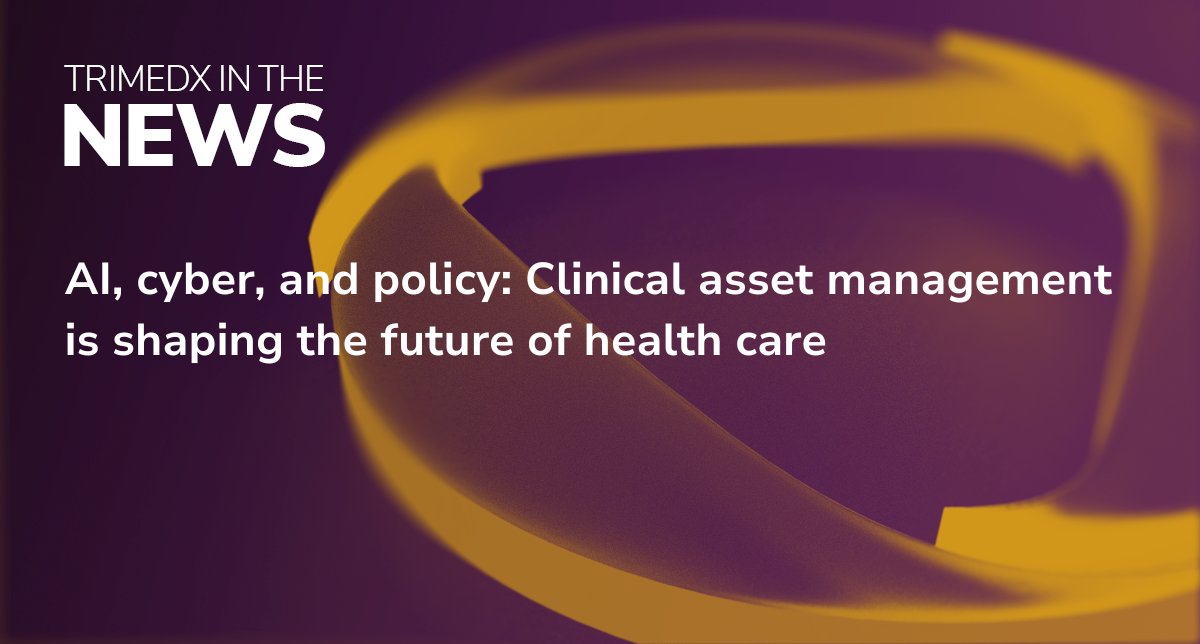TRIMEDX Chief Commercial Officer Ted Dunham recently wrote in AAMI Array about how AI, cybersecurity, and regulation are reshaping clinical asset management and driving the need for smarter, more resilient systems. Echoing TRIMEDX’s 2025 Industry Report, he stresses that strong policy frameworks and cyber safeguards are essential for technology to deliver safer, more efficient patient care.
The healthcare industry, including medical device professionals, is navigating a period of profound transformation. From the rapid rise of Generative AI to the intensifying focus on cybersecurity and the growing momentum behind Right to Repair legislation, clinical asset management is emerging as a strategic lever for innovation, resilience, and better patient outcomes.
At TRIMEDX, we recently convened a group of healthcare executives to explore these trends in depth. The insights shared in our 2025 industry report reveal a sector at a crossroads — where technology, regulation, and operational strategy intersect in ways that demand bold leadership and collaborative action.
Generative AI: From Buzzword to Bedside
Generative AI (GenAI) is no longer a futuristic concept — it’s a present-day imperative. The implications are vast. AI can help address the healthcare system’s chronic labor shortages by augmenting human capabilities and streamlining workflows. It can also process and analyze the enormous volumes of unstructured data generated daily in clinical settings — data that often goes underutilized. By doing so, GenAI can support more accurate diagnoses, personalized treatment plans, and better-informed care decisions. For technicians, this unlocked productivity also affords more time for proactive rounding and meaningful consultation with caregivers.
But the path forward isn’t without obstacles. Regulatory uncertainty, cultural resistance, and the sheer pace of technological change present real challenges. Healthcare leaders must take an active role in guiding their organizations through this transformation — collaborating with AI developers, investing in governance, and ensuring that proprietary data is used strategically and ethically.
Cybersecurity: A Systemic Risk Demanding Systemic Solutions
As health care becomes more digitized, cybersecurity has evolved from an IT concern to an enterprise-wide risk. Our report highlights a critical gap in basic cybersecurity practices — such as network segmentation — and a pressing need for stronger collaboration between hospitals, vendors, and federal agencies.
Healthcare organizations must integrate cybersecurity into their overall risk management strategies. This includes adopting best practices like multi-factor authentication, data encryption, and real-time monitoring. It also means preparing for the future, where AI will be used not only to defend against threats but also by attackers to exploit vulnerabilities.
Right to Repair: A Movement Gaining Momentum
The Right to Repair movement is gaining traction in health care. The 2025 Industry report looks back on how leading service providers, including TRIMEDX, have been advocating for competitive service options since 2016, when we first responded to an FDA docket questioning who should be allowed to service medical devices.
The Right to Repair is an important topic that touches on not only cost-saving, but questions about access to timely service of critical equipment. Please download the full report to learn more.
Capital Planning and Clinical Engineering Integration
Financial constraints are a constant in health care, and capital planning remains a delicate balancing act. That’s why data-driven asset management is so essential. It allows organizations to extend the life of their equipment, prioritize investments, and make better-informed decisions.
Another key theme from our report is the evolving relationship between clinical engineering (CE) and IT. Should CE report to IT, operations, or stand alone? There’s no one-size-fits-all answer, but what’s clear is that collaboration is critical. IT teams often lack the on-the-ground support needed for medical equipment maintenance, while CE teams need access to the infrastructure and cybersecurity expertise that IT provides.
Bridging this gap requires clear alignment, shared goals, and a commitment to cross-functional teamwork.
Looking Ahead: Innovation on the Horizon
Health care is at a pivotal moment. The convergence of AI, cybersecurity, regulatory change, and financial pressure is reshaping how we think about clinical asset management. But with the right strategies, the right partnerships, and a shared commitment to innovation, we can turn these challenges into opportunities.
By embracing technology, advocating for fair practices, and investing in data-driven decision-making, we can build a healthcare system that is more resilient, more efficient, and ultimately more focused on what matters most: delivering safe, high-quality care to every patient.
